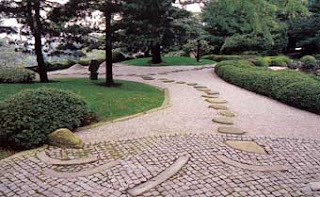Sound, an Overlooked Element in Landscape Design
Sound is an overlooked element in landscape design.
When we think of sound in a garden we think of birds singing, leaves rustling or bees buzzing.
Or we may think of wind chimes...
For some ideas we can look to ancient Japanese gardens where sound was a key consideration in the overall plan.
When we think of sound in a garden we think of birds singing, leaves rustling or bees buzzing.
 |
| Tim Cline Wind Chimes |
For some ideas we can look to ancient Japanese gardens where sound was a key consideration in the overall plan.
 |
| Stone Path - Japanese Garden at Kykuit |
"... The hollow tones of the shishi-odoshi (lit. 'deer-scare') – a rhythmic knock of bamboo on rock – the splash of the waterfall into a deep pool, the rustle of breezes through the bamboo, mute the rush of the world today,
creating a space for contemplation and meditation, for a mindful walk..., transporting one to another world, another reality."
creating a space for contemplation and meditation, for a mindful walk..., transporting one to another world, another reality."
 |
| 'deer scare' - shishi odoshi |
Wow. I couldn't have said it better.
The Japanese gardeners used sound to heighten the sense of 'near' and 'far' in a garden.
They would make a cascade seem far away by muffling its sound with strategically placed plants or rocks. The obstacles bounced the sound back and created the impression that the waterfall was in the distance when it was really around the corner along the garden path!
They would make a cascade seem far away by muffling its sound with strategically placed plants or rocks. The obstacles bounced the sound back and created the impression that the waterfall was in the distance when it was really around the corner along the garden path!
in Hyatt Hotel in Kauai- phoot by Jan Johnsen
This is why I always plant around a waterfall with great care, placing the plants where they might muffle the sound...
I normally locate evergreens on one side of a waterfall to act as a visual backdrop and as a sound buffer. These may include hemlock, juniper, rhododendron, Manhattan euonymus, Dwarf threadleaf cypress (Chamaecyparis pisifera filifera), weeping norway spruce, boxwood and leatherleaf Viburnum.
I also use smaller plants in the front or front side of a cascade such as Persicaria affinis 'Donald Lowndes' (Knotweed or Fleeceflower), dwarf Chinese Astilbe (Astilbe chinensis pumila), Japanese Painted Fern (Athyrium niponicum ‘Pictum’), Maidenhair fern, Iris, sedum and various varieties of cotoneaster.
Cascade by Jan Johnsen
I also use smaller plants in the front or front side of a cascade such as Persicaria affinis 'Donald Lowndes' (Knotweed or Fleeceflower), dwarf Chinese Astilbe (Astilbe chinensis pumila), Japanese Painted Fern (Athyrium niponicum ‘Pictum’), Maidenhair fern, Iris, sedum and various varieties of cotoneaster.
Similarly, Japanese garden designers would play with the sound of footsteps. In old Japan
Thus, garden paths paved with stone intensified the sound of footfalls while paths of tamped earth dampened the sound considerably. And, of course, gravel paths provided a crunching sound. Garden Designers would design for the varying sound of the foot falls.
Alas, our soft-soled shoes of today do not make the sound of a path as obvious but it is still audible.
I hope the sounds of the season will grab your attention...
Thus, garden paths paved with stone intensified the sound of footfalls while paths of tamped earth dampened the sound considerably. And, of course, gravel paths provided a crunching sound. Garden Designers would design for the varying sound of the foot falls.
Alas, our soft-soled shoes of today do not make the sound of a path as obvious but it is still audible.
 |
| Crunchy Gravel Walk |












What an interesting post. Sound is rarely considered except in Asian gardens. The details of how Japanese gardeners varied the sounds is something I may try in my own garden, Glen Villa.
ReplyDeleteThanks Pat! I hope you try it....and then wear something other than sneakers...:-)
DeleteGreat post, given me new inspiration!
ReplyDeleteLaurin - I hope you let me know if you ever do something like this in one of your projects...
DeleteI am truly inspired from your write-up and sharing this too with my friends and colleagues.
ReplyDeletelandscaper Novato
Thanks Jennifer! I appreciate that...
Delete